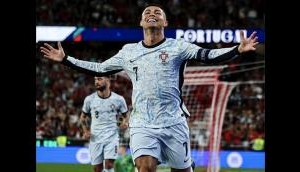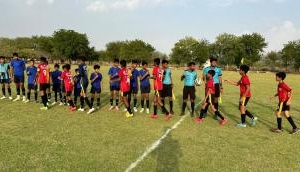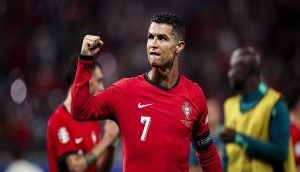
The much-awaited second season of the Indian Super League (ISL) is set to kick off on Saturday, 3 October, in Chennai, with Chennaiyin FC hosting defending champions Atletico de Kolkata at the city's Marina Arena stadium. With many football stars of the past involved in the tournament, there is understandably a lot of buzz among the football fans in the country.
While India recently slumped to 167 in the FIFA World Rankings, all the ills plaguing the game have been put into the back-burner as the country heads to the second season of IMG-Reliance's football tournament. So what exactly is the ISL? Who are its stakeholders? More importantly, does Indian football profit from it? Here is all you need to know.
The origins
In December 2010, the All India Football Federation (AIFF) signed a 15-year deal with IMG-Reliance. The deal gave IMG-R the exclusive commercial rights to sponsorship, advertising, broadcasting, merchandising, video, franchising, and rights to create a new football league, in return for Rs 700 crore. AIFF, operating under financial restraints, essentially sold off its decision-making power to IMG-R in the process through the deal.
The 'new league rights' that AIFF sold to IMG-R still remains a contentious issue. World football governing body FIFA does not allow more than one national league in a country. Yet, while it does not officially recognise ISL, it has, in AIFF president Praful Patel's own words, given India 'special dispensation' to start the tournament.
Initially slated to start in January, 2014, the first season of the tournament had to be pushed back by nine months after complications relating to availability of players and readiness and playing facilities. With many clubs playing in the I-League (India's only recognised national football league) opposing the creation of a new league, it took IMG-Reliance a few months to finally get the required number of players for the tournament.
The stakeholders
Atletico de Kolkata - owned by Kolkata Games and Sports Pvt. Ltd. (Atletico Madrid, Sourav Ganguly, Harshavardhan Neotia, Sanjiv Goenka and Utsav Parekh)
Chennaiyin FC - jointly owned by Abhishek Bachchan, Vita Dani and Mahendra Singh Dhoni
Delhi Dynamos FC - owned by DEN Networks
FC Goa - owned by Goan Football Club Pvt. Ltd. (Dattaraj Salgaocar, Shrinivas Dempo, Venugopal Dhoot and Virat Kohli)
FC Pune City - jointly owned by Wadhawan Group, ACF Fiorentina and Hrithik Roshan
Kerala Blasters FC - jointly owned by Sachin Tendulkar and PVP Group
Mumbai City FC - jointly owned by Ranbir Kapoor and Bimal Parekh
NorthEast United FC - owned by John Abraham
The Indian Super League has eight teams competing in it. Held in two phases, the top four finishers in the league phase progress to the semi-finals, before the winners clash in the final.
Atletico de Kolkata emerged triumphant in the first season, beating Kerala Blasters 1-0 in the final. Earlier in the season, Chennaiyin FC had topped the league phase, but were beaten by Kerala Blasters in the two-legged semi-final.
Sponsorship and broadcasting
The I-League has, over the years, failed to attract enough sponsors to grow into a profit-making entity. One of the reasons behind it is the structure of the tournament, which the AIFF has adamantly refused to change. However, the Indian Super League has managed to seduce many corporate bigwigs in a short span of time so far.
While Hero are the main title sponsors, the number of associate sponsors have seen a rise after the success of the first season. The likes of Flipkart, HP Enterprise, DHL, etc have put in considerable amounts this season, leading to the central sponsorship pool rising from Rs 55 crore in the first season to Rs 100 crore this term.
On the other hand, Star Sports, who hold a stake in the tournament, are the official broadcasters of the tournament. The first season saw a quality of production that had never previously been witnessed in Indian football, with Star also broadcasting the games on eight regional and national channels, in five different languages.
Does Indian football benefit from ISL?
The AIFF has constantly maintained that the motive of the ISL is to bring Indians into watching Indian football. The first season was definitely a huge success in terms of the number of viewers: the total views on TV was an astounding 429 million, while the attendance in stadiums throughout the tournament crossed the 1.5 million mark.
However, while ISL has indeed made Indians take notice of the domestic game, it's inconvenient scheduling has led to the I-League being curtailed to a four-month affair. India's cup competition, the Federation Cup, has been scrapped, and even the national team has been affected.
The AIFF, meanwhile, is increasingly becoming weaker as the authoritative body of the Indian game. Instead, the corridors of power have gradually shifted to IMG-Reliance in recent months. Recently, the latter objected to the Indian head coach's demand for holding a training camp ahead of the crucial FIFA World Cup qualifiers against Turkmenistan and Oman on 8 October and 13 October, respectively.
The training camp has been cancelled, and the players will now be released four days before India play Turkmenistan in Ashgabat. This is what a senior AIFF official told NDTV about the entire incident: "We are helpless. We are being dictated and have no choice but to support the ISL organisers."
Today, a large number of Indian footballers, including some of the country's brightest prospects, have been robbed of competitive action because of the way ISL has been scheduled. There is increasing consensus, even within AIFF, that a middle ground needs to be reached between I-League and the ISL, for domestic football in India to survive. How that materialises is yet to be seen.
However, the one thing that looks clear is that as long as India focuses on football at the top of the pyramid and ignores football at the grassroots, while also stifling its domestic league, there is little hope for the sport in India.








![BJP's Kapil Mishra recreates Shankar Mahadevan’s ‘Breathless’ song to highlight Delhi pollution [WATCH] BJP's Kapil Mishra recreates Shankar Mahadevan’s ‘Breathless’ song to highlight Delhi pollution [WATCH]](https://images.catchnews.com/upload/2022/11/03/kapil-mishra_240884_300x172.png)

![Anupam Kher shares pictures of his toned body on 67th birthday [MUST SEE] Anupam Kher shares pictures of his toned body on 67th birthday [MUST SEE]](https://images.catchnews.com/upload/2022/03/07/Anupam_kher_231145_300x172.jpg)






